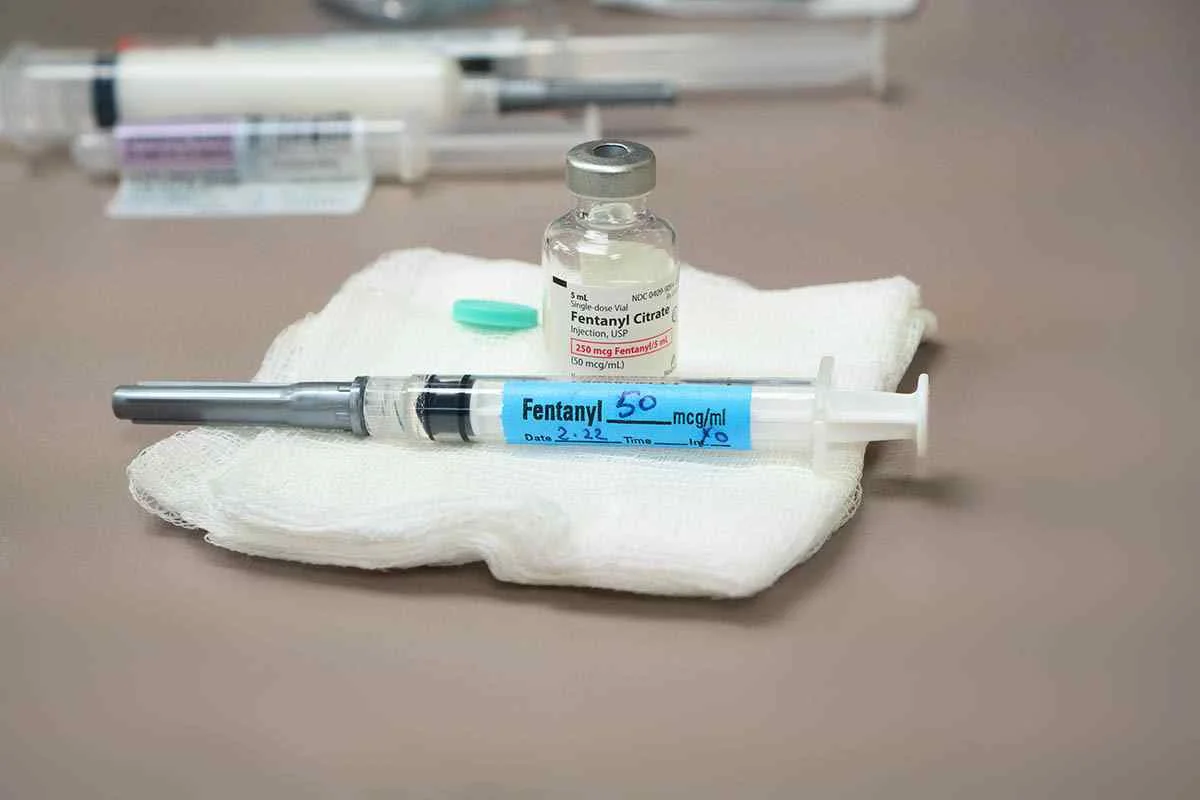Fentanyl

Fentanyl is a potent opioid medication that is used in the treatment of chronic or breakthrough pain.
Common Trade Names: Abstral, Actiq, Duragesic, Fentora, Onsolis, Sublimaze
A powerful narcotic analgesic, fentanyl is a Schedule II drug under the federal drug scheduling system, which means it has a high potential for abuse that could possibly lead to severe psychological or physical dependence. While fentanyl does have accepted medical value, its association with high risks of opioid dependence and addiction means that it’s typically reserved for managing pain in patients for whom non-opioid analgesics or other forms of opioids are not adequate.
Medical Uses of Fentanyl
Fentanyl is a powerful opioid used to treat pain of moderate to severe intensity that requires long-term, round-the-clock pain management. It is typically given to patients who experience breakthrough pain, or sudden episodes of pain that happen in spite of continuous treatment with pain medication.
How People Abuse Fentanyl
Fentanyl presents a significant risk of drug overdose because of its potency. Here are just some of the ways the drug is abused:
- Using multiple fentanyl patches to heighten its strength
- Mixing the narcotic fentanyl gel from patches with water and then drinking it
- Crushing buccal tablets, sublingual tablets, or lozenges before mixing it with water and drinking it.
- Heating fentanyl gel from patches and inhaling the resulting smoke
- Mixing fentanyl gel or pure fentanyl powder with water and then injecting it directly into the bloodstream
- Mixing fentanyl with low-quality heroin, cocaine, crystal methamphetamine, and other drugs
The illegal manufacture and sale of fentanyl has been implicated in the outbreak of overdose deaths that occurred between the years 2005 and 2007 in the states of New Jersey, Maryland, Illinois, Michigan, and Pennsylvania.
Fentanyl Drug Interactions
Fentanyl is primarily metabolized via CYP3A4, an important enzyme found primarily in the liver and in the intestines that oxidizes foreign substances like drugs. As such, fentanyl may interact with other agents that also affect CYP3A4 activity. In particular, the following drugs can increase blood concentrations of fentanyl and magnify its respiratory depressant effects:
Strong CYP3A4 inhibitors
- Clarithromycin
- Itraconazole
- Ketoconazole
- Nefazodone
- Nelfinavir
- Ritonavir
- Troleandomycin
Moderate CYP3A4 inhibitors
- Amprenavir
- Aprepitant
- Diltiazem
- Erythromycin
- Fluconazole
- Fosamprenavir
- Verapamil
Grapefruit and grapefruit juice can also have a similar inhibitory effect on CYP3A4, which can also increase concentrations of fentanyl in the blood.
Finally, fentanyl is also not recommended for concomitant use with MAO inhibitors because MAO inhibitors can severely increase the potency of opioid analgesics.
Side Effects of Fentanyl
Similar to other opioids, fentanyl can produce several adverse effects, including the following:
- Lack of energy
- Headache
- Back pain
- Chest pain
- Nausea
- Vomiting
- Constipation
- Gas and gas pain
- Stomach pain
- Heartburn
- Painful urination
- Dry Mouth
- Dizziness
- Anxiety
- Depression
- Confusion
- Insomnia or difficulty falling asleep or staying asleep
- Abnormal gait
- Shortness of breath
Fentanyl use can also result in sudden onset of side effects that may indicate a life-threatening situation:
- Changes in heartbeat
- Severe muscle stiffness
- Shivering
- Vomiting
- Seizures
- Hives
- Rashes
- Itching
If you observe these symptoms in yourself or another individual, call your doctor or get help from 911 immediately.
Effects of Fentanyl Use over the Long Term
Chronic use of fentanyl can result in other side effects that can manifest after several weeks or months. The potential long-term effects of fentanyl use include:
- Asthenia or weakness
- Digestive tract distress
- Prolonged headaches
- Dizziness
- Anxiety
- Somnolence
- Inability to get an erection
- Changes in menstruation patterns
- Weight loss
- Changes in sleeping patterns
Signs of Fentanyl Overdose
Fentanyl is a powerful opioid drug, and overdosing on it is very much a possibility if it is misused. The symptoms of fentanyl overdose include:
- Drowsiness or sleepiness
- Dizziness
- Confusion
- Shortness of breath
- Stopped breathing
- Pinpoint pupils (appears as small black circles in the middle of the eyes)
- Blue discoloration of the skin
- Cold and clammy skin
- Unresponsiveness
- Inability to wake up
- Coma
Call 911 or take the patient to the hospital immediately if an opioid overdose is suspected. If a member of your family is medicating on fentanyl or is at risk of abusing it, talk to your doctor about getting a rescue drug called naloxone. It can be used to reverse the potentially fatal effects of an opioid overdose by relieving the symptoms associated with it.
Signs That Someone Is Addicted to Fentanyl
Fentanyl is one of the most commonly abused opioids in the United States. Chronic use of fentanyl can result in an opioid use disorder. The Diagnostic and Statistical Manual of Mental Disorders, Fifth Edition (DSM-5) provides a criteria for substance use disorders, which can be used to determine if an individual has developed an addiction to fentanyl. These signs include:
- Using fentanyl in amounts that are greater than prescribed or for a longer period than necessary
- Desiring to cut down on or to stop using fentanyl, yet being unable to
- Spending a significant amount of time to get, use, or recover from use of fentanyl
- Craving for fentanyl
- Not being able to manage commitments or obligations because of fentanyl use
- Continuing to use the substance even when it causes relationship problems
- Giving up on important activities because of the need to use fentanyl
- Continuing to use fentanyl despite being put in danger because of the drug
- Continued to use the substance even if it leads to exacerbation of physical or psychological problems
- Increasing tolerance to fentanyl
- Developing withdrawal symptoms that manifest when fentanyl use is stopped
Fentanyl Withdrawal Symptoms
If you have developed a dependence on fentanyl, abruptly stopping use of the drug will cause you to experience withdrawal symptoms. These can include the following:
- Agitation
- Sweating
- Confusion
- Rapid heartbeat
- Shivering
- Stiffening or twitching of the muscles
- Nausea and vomiting
- Diarrhea
These withdrawal symptoms are indicative of opioid dependence. While physical dependence on fentanyl usually does not happen until after a few weeks of non-stop use of the drug, it’s important to note that dependence can occur whether you use fentanyl as prescribed or you misuse it. Dependence also doesn’t necessarily mean you’re addicted to the drug. It just means that you can’t abruptly stop using the drug to avoid negative consequences to your health. Instead, you should talk to your physician about creating a proper tapering schedule for you.
Fentanyl Detox
Experiencing withdrawal syndrome because of fentanyl dependence can cause tremendous pain and discomfort, which is why you shouldn’t attempt to abruptly stop using the drug. A fentanyl detox program is specifically designed to help you deal with withdrawal as safely and as comfortably as possible.
In a medical detox facility, a team of professionals will give you round-the-clock care while also providing you with opioid withdrawal medications, symptomatic medications, nutritional supplements, and IV fluids. With these interventions, you’ll be better set for the next step of your journey to recovery.
Finding Treatment for Fentanyl Addiction
In the US, fentanyl remains to be one of the most commonly abused opioid analgesics. Most cases related to fentanyl abuse, including overdose and deaths, are linked to illegally produced and sold fentanyl. The continuous rise in the number of fentanyl users underlines the need for immediate and indiscriminate access to care.
Fentanyl addiction treatment programs mainly occur in two types of settings:
- Inpatient fentanyl addiction treatment: This is the most intensive treatment option available to individuals dealing with this particular opioid use disorder. In an inpatient setting, you will be afforded a mix of treatment modalities, including medication-assisted treatment, as well as individual therapy, group counseling, family therapy, and drug education sessions. These therapies are aimed at helping you achieve a drug-free life by teaching you better ways to cope with relapse triggers and recognizing possible roadblocks that could slow down or jeopardize your treatment. They can also help you identify and correct maladaptive behavioral patterns that increase your risk for substance abuse.
- Outpatient fentanyl addiction treatment: In this setup, you will be allowed to stay in your home while attending scheduled therapy and counseling sessions at a treatment center. While this option is less intensive, it may be better suited to people with milder forms of addiction and are able to receive strong support from their families. One other advantage of outpatient treatment is you will be able to continue with most of your daily routines, even attending school or going to work.
Reach Out to a Recovery Support Advisor Today
The first step in overcoming addiction is deciding to get help, and you can do it now. You’ll be glad to know that most insurance plans provide a certain level of coverage for addiction treatment services, which means you likely won’t have to pay for everything out of pocket.
Call us now at (800) 429-7690 to speak to a recovery support advisor. They will be able to help you verify your insurance status or coverage and find a treatment facility that suits you best. And even if you don’t currently have insurance coverage, there are plenty of other ways to finance your treatment. The most important thing is to take that first step to recovery today.
How Fentanyl Was First Discovered and Used
Fentanyl was synthesized in the 1960s as a result of numerous scientific experiments seeking to discover opioids with greater potency and wider safety indices. Before the discovery of fentanyl, older opioids were used, but they were associated with problems involving morphine-oxygen anesthesia, including respiratory depression and incomplete amnesia.
After the development of fentanyl, researchers began exploring its effects both on animals and humans. One of the earliest studies conducted was the anesthetic effect of 50-100 mcg fentanyl with 100% oxygen on patients undergoing coronary artery or mitral valve surgery. The study concluded that fentanyl could be a potent anesthetic, but it was also associated with cardiovascular and respiratory depression, as well as muscle rigidity.
Today, Fentanyl is used to treat individuals with severe pain following surgery or chronic severe pain due to medical conditions. It is a Schedule II drug that is recognized as a substance being similar to morphine but with 100 times more potency.


